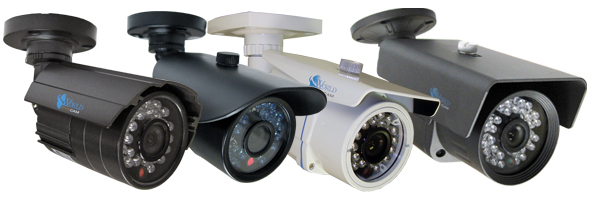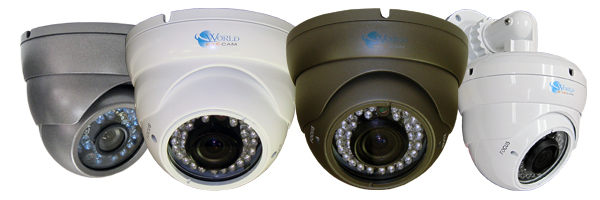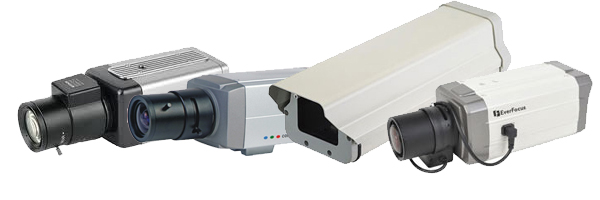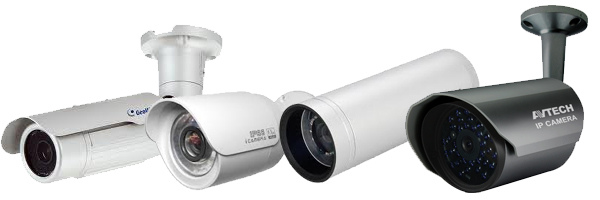What type of surveillance cameras is better suited for you?
On the security market today there is a very large number of different cameras for video surveillance, their classification can vary both from external performance, additional functions, the possibility of performance and the type of work with the video signal.
Which camera is best for you depends on many factors, for example, whether you will use the camera indoors or outdoors, in the dark or daytime, what area and in what quality the camera should cover, what temperature conditions or the level of aggressiveness of the environment in the place installation and from much more.
The main division of cameras is according to the type of work with the image: analog, HD-SDI or digital (network) IP-cameras.
Separation of external execution goes to:
- dome cameras
- cylindrical, outdoor (bullet) cameras
- camera cube
- case (box) cameras
- fisheye panoramic cameras
- hidden cameras.
By additional functions of the camera can be classified into:
- Cameras with infrared illumination (IR)
- Cameras with dynamic range (WDR)
- Controlled, PTZ PTZ cameras (Speed Dome)
- Wi-Fi wireless cameras
Outdoor cameras in the performance of bullet today are the most popular and best-selling cameras. They can be installed both outdoors and indoors.
The cases of these cameras are usually designed for protection classes IP66 and IP67, which allows them not to be afraid of various weather conditions (rain, dust, frost). Most of these cameras have a fixed 3.6 mm lens, which allows you to approximately identify a person at a distance of about 5-10 meters and provides a 24_ports degree viewing angle.
Infrared cameras (cameras with IR illumination) are very popular today, as they allow you to see what is happening on the subject even in the complete absence of lighting. Previously, IR illumination was the prerogative of street cameras, since at night ordinary cameras practically did not see anything, today you can also find internal cameras with IR illumination. These cameras have a different number of IR diodes installed around the lens (depending on the power and range of illumination), which allow the camera to see without light at a distance of 10 to 40 meters.
The advantage of the box version of the security camera is that they are cheaper than bullet cameras, and that you can change the camera lens yourself to the one you need, and you can install this camera both indoors and on street (in the containment).
CCTV cameras are becoming an integral part of not only commercial facilities, but also ordinary residential buildings. Modern models offer a wide range of features, including night vision, motion detection, and high resolution, making them an ideal choice for protecting private property. An important advantage is the ability to integrate cameras into the Smart Home system, which allows you to manage and monitor the security of your home remotely through a mobile application or computer, providing an additional level of protection and comfort.
Bullet cameras

The term bullet comes from the similarity of the appearance of the camera with a gun bullet. It is generally elongated and conical like a cylinder. Cylindrical cameras are equipped with a universal mounting bracket, which facilitates the installation process of these cameras.
Cylindrical outdoor cameras can be equipped with both a fixed lens and a varifocal (variable focus) lens. Typically, these cameras are equipped with a fixed lens with a focal length of 3.6 mm. Other lenses are also possible, but 3.6mm is the most common. Thanks to varifocal lenses, you can adjust the focal length directly during installation. Varifocal lenses for such cameras are usually 2.8 - 12 mm, which allows you to either adjust a wide viewing angle (to the detriment of quality) or vice versa greatly increase the required area.
Modern street cameras show a color picture during the day, and for night viewing, the infrared illumination is turned on by the light sensor and the camera switches to night mode (black and white image) which captures the image in black and white at night. The resolution of such cameras varies from 420 to 700 TV lines, the higher the number of TV lines, the better the picture, if you want a more detailed and high-quality image (from HD to 4K) you should look in the direction of digital ip-cameras or HD-SDI cameras.
Bullet cameras contain the same electronics as other cameras. In terms of image quality, nothing makes these cameras better or worse than dome cameras for example. They differ in that these cameras have built-in infrared illumination, as well as an increased level of weather protection IP66 or IP67, sometimes a heating and cooling system and of course the shape
Bullet cameras typically use 12 volts DC. However, there are variations on 24 volts. The performance of Bullet cameras (cylindrical) can be found in both analog, IP and HD-SDI formats.
Dome cameras

The dome camera is named after the dome that closes the lens. Everyone saw these cameras for surveillance at enterprises in banks and stores. Due to its shape and the dome that covers the lens, it is difficult to determine exactly where the camera is directed and it is not clear whether this camera is looking at you or in the opposite direction. Dome cameras are usually used for installation inside buildings, although there are options with external anti-vandal dome cameras, some of them are even equipped with IR illumination. These cameras are easily installed both on the wall and on the ceiling of the building. Resolution can also be in the range from 420 to 700 TV lines. Due to their design, these cameras are less visible and an unaware person may not even realize that this is a surveillance camera.
Usually dome cameras are located in the corner of the room to capture the maximum area
Box cameras

The main advantage of Box cameras is that in these cameras it is easy to change the lens to the one you need. These cameras are sometimes even referred to as “C-Mount” cameras, in honor of the mount standard for C-Mount lenses. If you need to see further than 10-15 meters, then you need to use these cameras with a special lens. C-Mount lenses for CCTV cameras can be found in versions from 2.8 mm to 100 mm. A lens with a large value allows you to see a detailed enlarged image, such as a face or banknote. Also, these cameras are cheaper than bullet cameras that are similar in characteristics and if you want to install them on the street, you can easily do this, just mount them in a pressure jacket.
PTZ (Speed dome) cameras

PTZ cameras – are controlled cameras, you can control them remotely, namely, turn them left and right, pan the image, tilt them up and down, also scale the image to zoom in and out to remove part of the image that interests you. Typically, a PTZ camera is controlled using a remote control (a special keyboard and joystick) or using the software of your video recorder. The main disadvantages of Speed dome cameras is that they are quite expensive and have a number of parts that wear out over time. Also, for high-quality security, it is necessary that the operator controls these cameras.
For analog Speed dome cameras, three cables must be connected: a power cable, a cable transmitting a video signal, and a control cable. Digital PTZ IP cameras can transmit all data on one cable, it is possible to transmit power on the same cable if the camera provides PoE power.
To fully understand the quality of the recording, set the maximum available resolution.
As with other types of cameras, PTZ PTZ cameras can be found both in analog and in HD-SDI and digital ip-format. With their unlimited viewing range, PTZ cameras are best suited for patrol mode (programmed, automatic viewing of the surrounding area. They can also be quite large, heavy, and require very specific mounting conditions. Those factors to consider when looking at a PTZ camera
Megapixel IP-cameras

Like analog, IP cameras use 12 or 24 volts. Also, IP-cameras can receive power using PoE (power via Ethernet cable). You can connect to all digital IP cameras remotely via the Internet, directly to a camera or video server (NVR), sometimes they are even called network cameras.
Due to the fact that ip-cameras offer higher resolution, they generate more traffic (up to 20 Mbps), as a result of which video storage requires much larger storage volumes (hard disks, SSD disks, network storage), and therefore good Internet bandwidth, at least 2-4 Mbps outgoing channel
The last technology that we will look at today is CCTV HD-SDI or HD CCTV. Just as in the case of IP-cameras and analog cameras, you can find HD-SDI cameras in any version: body, outdoor, dome and even PTZ. HD-SDI differs from IP in that HD-SDI cameras generate a digital image and transfer the uncompressed digital video stream directly to the video server via coaxial cable, and the video server already encodes them in H.264 or MJPEG codecs.
To fully understand the quality of the recording, set the maximum available resolution.
HD-SDI cameras deliver excellent FullHD picture without delays or interference. This is very important for high-risk areas, such as cash registers, banks and casinos, where it is necessary to clearly and without delay see the moment of transfer of money up to the face value of the banknote. Just like IP cameras, HD-SDI cameras allow you to cover large areas in high resolution and one camera can replace up to 4 analog cameras.
Here you can buy and order the installation of any cameras, both analog and ip, as well as get advice on any issues related to security systems.
Tel: (044) 361-59-01, (067) 123-62-98
Or email us: info@kristalls.com.ua
